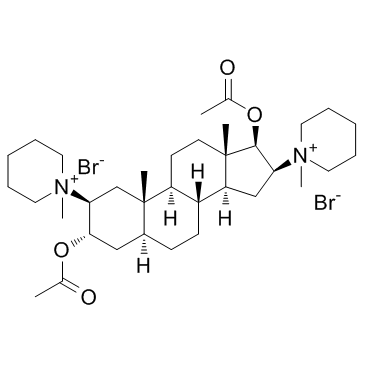Pancuronium dibromide

Pancuronium dibromide structure
|
Common Name | Pancuronium dibromide | ||
|---|---|---|---|---|
| CAS Number | 15500-66-0 | Molecular Weight | 732.67000 | |
| Density | N/A | Boiling Point | N/A | |
| Molecular Formula | C35H60Br2N2O4 | Melting Point | 214 - 217ºC | |
| MSDS | USA | Flash Point | N/A | |
| Symbol |

GHS06 |
Signal Word | Danger | |
Use of Pancuronium dibromidePancuronium Dibromide is a bis-quaternary steroid that is a competitive nicotinic antagonist.Target: nAChRPancuronium dibromide is a competitive AChR antagonist (IC50 = 5.5 nM) and acts as a skeletal muscle relaxant. Pancuronium dibromide interrupts neuromuscular transmission by competing with acetylcholine for receptor sites on the motor end-plate. Pancuronium dibromide is a non-depolarizing agent. Pancuronium is a typical non-depolarizing curare-mimetic muscle relaxant. It acts as a competitive acetylcholine antagonist on neuromuscular junctions, displacing acetylcholine (hence competitive) from its post-synaptic nicotinic acetylcholine receptors. It is (unlike suxamethonium) a non-depolarizing agent, which means that it causes no spontaneous depolarizations upon association with the nicotinic receptor in neuromuscular junction, thus producing no muscle fasciculations upon administration [1-3]. |
| Name | pancuronium bromide |
|---|---|
| Synonym | More Synonyms |
| Description | Pancuronium Dibromide is a bis-quaternary steroid that is a competitive nicotinic antagonist.Target: nAChRPancuronium dibromide is a competitive AChR antagonist (IC50 = 5.5 nM) and acts as a skeletal muscle relaxant. Pancuronium dibromide interrupts neuromuscular transmission by competing with acetylcholine for receptor sites on the motor end-plate. Pancuronium dibromide is a non-depolarizing agent. Pancuronium is a typical non-depolarizing curare-mimetic muscle relaxant. It acts as a competitive acetylcholine antagonist on neuromuscular junctions, displacing acetylcholine (hence competitive) from its post-synaptic nicotinic acetylcholine receptors. It is (unlike suxamethonium) a non-depolarizing agent, which means that it causes no spontaneous depolarizations upon association with the nicotinic receptor in neuromuscular junction, thus producing no muscle fasciculations upon administration [1-3]. |
|---|---|
| Related Catalog | |
| References |
| Melting Point | 214 - 217ºC |
|---|---|
| Molecular Formula | C35H60Br2N2O4 |
| Molecular Weight | 732.67000 |
| Exact Mass | 730.29200 |
| PSA | 52.60000 |
| LogP | 0.03610 |
| Storage condition | Desiccate at RT |
CHEMICAL IDENTIFICATION
HEALTH HAZARD DATAACUTE TOXICITY DATA
|
| Symbol |

GHS06 |
|---|---|
| Signal Word | Danger |
| Hazard Statements | H301 |
| Precautionary Statements | Missing Phrase - N15.00950417 |
| Personal Protective Equipment | dust mask type N95 (US);Eyeshields;Faceshields;Gloves |
| Hazard Codes | Xn:Harmful; |
| Risk Phrases | R22 |
| RIDADR | UN 2811 6.1/PG 3 |
| WGK Germany | 3 |
| RTECS | TN4930000 |
| Packaging Group | III |
| Hazard Class | 6.1(b) |
|
Regional lung tissue changes with mechanical ventilation and fluid load.
Exp. Lung Res. 41(4) , 228-40, (2015) To investigate the regional gravity-dependent impact of mechanical ventilation and fluid overload on lung extracellular matrix (ECM) in healthy lungs.The glycosaminoglycans (GAGs) composition of the v... |
|
|
Chemical genetics reveals a complex functional ground state of neural stem cells.
Nat. Chem. Biol. 3(5) , 268-273, (2007) The identification of self-renewing and multipotent neural stem cells (NSCs) in the mammalian brain holds promise for the treatment of neurological diseases and has yielded new insight into brain canc... |
|
|
Genetic mapping of targets mediating differential chemical phenotypes in Plasmodium falciparum.
Nat. Chem. Biol. 5 , 765-71, (2009) Studies of gene function and molecular mechanisms in Plasmodium falciparum are hampered by difficulties in characterizing and measuring phenotypic differences between individual parasites. We screened... |
| EINECS 239-532-5 |
| MFCD00079223 |
| Pancuronium dibromide |
| Pancuronium Bromide |

